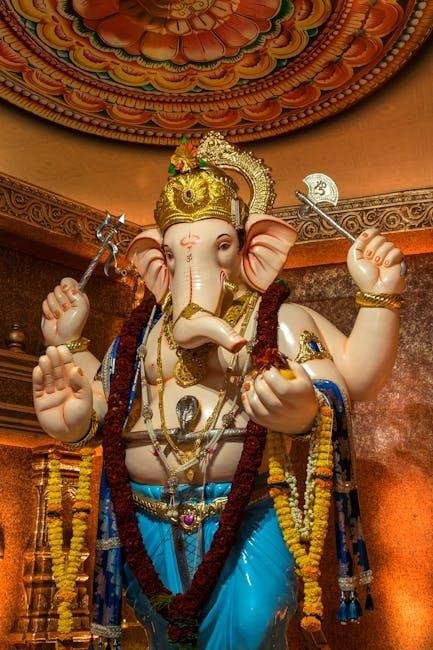The PDF version of Lord of the Flies offers a convenient and accessible way to read William Golding’s classic novel. With page-by-page annotations and easy digital navigation, the PDF format enhances readability while preserving the original text’s depth. Its popularity stems from its portability and compatibility with various devices, making it a preferred choice for modern readers and students alike.
1.1 Overview of the Novel’s Availability in PDF Format
Lord of the Flies is widely available in PDF format, making it easily accessible for readers worldwide. The novel can be downloaded from various legal sources, including official publishers, online bookstores, and educational platforms. Many websites offer free or paid versions of the PDF, catering to different reader preferences. The digital format ensures that the text is searchable, annotatable, and compatible with multiple devices. Additionally, the PDF version often includes annotations, study guides, and supplementary materials, enhancing the reading experience for students and literature enthusiasts. Its availability in PDF has significantly contributed to its popularity, allowing readers to engage with Golding’s timeless story in a modern, convenient way.
1.2 Why Readers Prefer the PDF Version
Readers prefer the PDF version of Lord of the Flies for its convenience and accessibility. The digital format allows easy reading on various devices, such as tablets, e-readers, and smartphones, making it ideal for on-the-go access. The PDF preserves the original formatting and structure of the novel, ensuring a seamless reading experience. Additionally, features like search functionality and annotatable text enhance usability, particularly for students and educators analyzing the book. The ability to store multiple PDFs on a single device also makes it space-efficient. Overall, the PDF version combines practicality and flexibility, appealing to both casual readers and academic users.
1.3 Key Features of the PDF Edition
The PDF edition of Lord of the Flies boasts several notable features that enhance readability and user experience. High-quality text and clear formatting ensure that the novel’s intricate dialogue and descriptive passages are easily legible. The PDF includes page-by-page annotations, providing deeper insights into key events and themes. Search functionality allows readers to quickly locate specific chapters or quotes. Additionally, the PDF is lightweight, making it easy to download and store on various devices. These features make the PDF edition a valuable resource for both casual readers and students studying the novel, offering convenience without compromising on content quality.

Major Themes in “Lord of the Flies”
The novel explores the nature of humanity, highlighting the conflict between civilization and savagery. It delves into how fear shapes behavior and the effects of isolation on morality.
2.1 The Nature of Humanity
Golding’s exploration of human nature reveals a duality between innate savagery and civilized behavior. The boys’ descent into chaos mirrors humanity’s primal instincts, showcasing how quickly societal norms can erode without external constraints. The novel suggests that humans are inherently flawed, with a capacity for both good and evil. This theme is central to the story, as the characters’ actions reflect deeper truths about human behavior, morality, and the effects of isolation. Through their struggles, Golding illustrates how environment and circumstance can uncover the darker aspects of human nature, challenging the idea of innate goodness. This insight remains timeless and universally relevant.
2.2 Civilization vs. Savagery
In Lord of the Flies, the conflict between civilization and savagery is a core theme. The novel portrays civilization as order, morality, and rationality, embodied by Ralph, while savagery is represented by Jack’s primal desires and the boys’ gradual descent into chaos. The conch shell symbolizes civilized discourse, but its power wanes as fear and primal instincts dominate. The beast becomes a metaphor for the boys’ inner fears, driving them toward savagery. Golding illustrates how quickly societal norms collapse without external authority, revealing humanity’s inherent duality. This timeless conflict underscores the novel’s exploration of human nature and the fragility of civilization in the face of primal instincts and fear. The island serves as a microcosm of societal breakdown, highlighting the ease with which savagery can prevail.

2.3 The Role of Fear and Its Impact
Fear plays a pivotal role in Lord of the Flies, driving the boys’ actions and decisions. Initially, the fear of the unknown, such as the beast, unites them, but it soon escalates into paranoia and division. Jack manipulates this fear to gain power, turning it into a tool of control. The fear of the beast symbolizes the boys’ internal anxieties and the collapse of their moral framework. As fear intensifies, it leads to violence, such as the death of Piggy, highlighting how fear can destroy rationality and civility. Golding uses fear to illustrate the darker aspects of human nature, showing how it can unravel societal norms and lead to chaos;

Key Events and Symbols in the Novel
The novel’s key events include the plane crash, the discovery of the conch shell, and the hunt for the beast. These events symbolize the boys’ struggle between order and chaos, highlighting themes of power, fear, and survival. The conch shell represents democracy and civility, while the beast embodies the boys’ deep-seated fears. Together, these elements create a rich narrative that explores human nature and societal collapse, making the novel a timeless classic in literature.
3.1 The Plane Crash and the Island Setting
The novel begins with a plane crash that strands a group of British schoolboys on a remote, uninhabited island. The crash, which occurs during an unspecified war, marks the beginning of their isolation from adult supervision. The island, described as a tropical paradise with dense forests, rocky shores, and coral reefs, initially symbolizes freedom and adventure. However, its isolation soon becomes a catalyst for the boys’ descent into chaos. The crash site, with its scattered debris, serves as a grim reminder of their circumstances. The island’s setting plays a crucial role in shaping the boys’ actions and decisions, as they struggle to survive and govern themselves in the absence of societal norms.
3.2 The Conch Shell as a Symbol of Order
The conch shell, discovered by Piggy, becomes a powerful symbol of order and democracy in the novel. Ralph uses it to summon the boys and maintain control during meetings, ensuring that only the holder can speak. This shell represents the rules and structure of civilization, providing a sense of authority and fairness. However, as the boys’ behavior becomes more savage, the conch’s influence wanes. Its eventual destruction mirrors the collapse of order on the island, highlighting the tension between civilization and primal instincts. The conch shell serves as a poignant reminder of the fragile nature of societal norms and the ease with which they can be abandoned.
3.3 The Beast and Its Significance
The Beast, a mysterious and terrifying entity, becomes a central fear for the boys on the island. Initially thought to be a physical creature, the Beast evolves into a symbol of their collective fears and primal anxieties. Jack Merridew manipulates this fear to gain power, using it to justify his savage actions and control over the group. The Beast also represents the unknown, reflecting the boys’ deep-seated dread of the unpredictable and their loss of innocence. Its significance lies in its psychological impact, driving the boys to paranoia and division. The Beast ultimately embodies the darker aspects of human nature, revealing how fear can unravel order and lead to chaos.

Character Analysis
The novel explores the diverse personalities and development of its characters, revealing their strengths, weaknesses, and moral struggles. Through their interactions, Golding examines themes like leadership, savagery, and morality.
4.1 Ralph: The Voice of Reason
Ralph, the protagonist, embodies leadership and civility. Elected as the leader, he focuses on building shelters and maintaining order, symbolizing hope and democracy. His fair hair and tall stature represent innocence and authority. However, as the novel progresses, Ralph’s leadership is challenged by Jack’s desire for power, leading to internal conflict. Despite this, Ralph remains a symbol of morality, advocating for the conch shell as a tool for democracy. His eventual defeat signifies the descent into chaos, highlighting the struggle between civilization and savagery. Ralph’s journey from innocence to disillusionment is central to the novel’s exploration of human nature.
4.2 Jack: The Descent into Savagery
Jack Merridew begins as a choirboy with a sense of discipline but gradually descends into savagery. His obsession with hunting and power grows, leading him to abandon civility. Jack’s desire for control and fear of the “beast” drive his actions, symbolizing the primal instincts within humanity. His descent is marked by his painted face and the creation of a pig’s head offering to the beast. Jack’s transformation reflects the novel’s theme of civilization vs. savagery, as he rejects reason and order, embracing chaos and violence. His character serves as a stark contrast to Ralph, highlighting the fragility of human morality when societal constraints are removed.
4.3 Piggy: The Embodiment of Intelligence
Piggy, with his rational thinking and logical approach, represents intelligence and wisdom in the novel. Despite his physical limitations, he consistently advocates for order, using the conch shell to maintain civility. Piggy’s focus on building shelters and starting fires with his glasses highlights his practicality. His belief in science and reason contrasts sharply with the boys’ growing fear of the “beast,” emphasizing the struggle between logic and superstition. Piggy’s eventual death symbolizes the loss of rationality and the collapse of civilized behavior on the island, underscoring his role as the moral and intellectual anchor of the group.

Themes and Their Relevance Today
Lord of the Flies explores timeless themes like human nature, isolation, and morality, which remain universally relevant. Its insights into societal dynamics and ethical dilemmas resonate strongly today.
5.1 The Effects of Isolation
Isolation plays a pivotal role in Lord of the Flies, as the boys’ detachment from society leads to a gradual unraveling of their civilized behavior. The absence of adult supervision accelerates this decline, highlighting how isolation can erode moral structures. The novel demonstrates that without societal norms, individuals may resort to primal instincts, leading to chaos and conflict. This theme remains relevant today, as modern society grapples with issues of loneliness and disconnection. The PDF version of the novel allows readers to delve into these themes with ease, making it a popular choice for both academic and personal exploration.
5.2 The Role of Leadership
Leadership in Lord of the Flies is a central theme, with Ralph and Jack representing opposing styles. Ralph embodies democratic leadership, focusing on collective welfare and order, while Jack symbolizes authoritarian control, driven by power and dominance. The novel highlights how leadership can shape a group’s behavior, with Ralph’s civility gradually giving way to Jack’s savagery. The PDF version allows readers to analyze these dynamics, emphasizing how leadership choices impact societal structures. This theme remains relevant, offering insights into the challenges of guiding groups and the consequences of leadership failures. The novel’s exploration of leadership continues to resonate, making it a timeless study of human nature.
5.3 Morality and Ethics in Society
The novel explores the erosion of morality and ethics when societal structures collapse. The boys’ descent from civilized behavior to primal instincts highlights how quickly moral frameworks can disintegrate without external enforcement. Initially, their adherence to rules and shared values reflects a basic understanding of ethics. However, as fear and power struggles intensify, their actions become more self-serving and violent. The PDF version underscores these themes through annotations, emphasizing the novel’s relevance to modern discussions on morality. Golding’s exploration of human nature raises questions about inherent goodness and the necessity of societal norms. This theme remains a critical lens for understanding human behavior in any context.

The Popularity of “Lord of the Flies” in PDF Format
The PDF version of Lord of the Flies is widely popular due to its accessibility, convenience, and compatibility with modern reading habits, making it a preferred digital choice.
6.1 Accessibility and Convenience
The PDF format of Lord of the Flies offers unparalleled accessibility and convenience. Readers can easily download and access the novel on various devices, including smartphones, tablets, and laptops, making it portable and adaptable to different reading preferences. The digital version eliminates the need for physical storage, allowing users to carry the entire book in a single file. Additionally, the PDF’s search functionality enables quick navigation through chapters and key themes, enhancing the reading experience. This convenience makes it an ideal choice for students, educators, and enthusiasts seeking a hassle-free way to engage with Golding’s timeless narrative.
6.2 Environmental Impact of Digital Books
The shift to digital books like the PDF version of Lord of the Flies significantly reduces environmental impact. By eliminating the need for paper, ink, and physical distribution, digital formats conserve natural resources and lower carbon emissions. This eco-friendly option aligns with growing sustainability efforts, making it a responsible choice for readers. Additionally, digital books minimize waste and storage requirements, further contributing to environmental preservation. As awareness of climate change grows, opting for digital copies becomes an increasingly mindful decision, ensuring that literature remains accessible while promoting a greener future for generations to come.
6.3 The Role of Technology in Reading Habits
Technology has revolutionized reading habits, making digital formats like the PDF of Lord of the Flies highly popular. E-readers, tablets, and smartphones enable readers to access the novel anywhere, fostering a more flexible reading experience. Features such as adjustable fonts, night modes, and bookmarks enhance readability and convenience. Digital tools also allow for easy annotations and quick searches, aiding students and scholars in studying the text. The rise of digital books reflects a broader shift toward tech-driven consumption of literature, offering a modern yet immersive way to engage with timeless stories like Lord of the Flies.

Literary Significance of the Novel
Lord of the Flies is a profound exploration of human nature, civilization, and morality, offering timeless insights into societal structures and individual behavior through its allegorical narrative.
7.1 William Golding’s Writing Style
William Golding’s writing style in Lord of the Flies is distinctive for its vivid descriptions and symbolic depth. His prose is both concise and evocative, creating a immersive experience. Golding masterfully employs imagery to depict the island’s beauty and the boys’ descent into savagery. His use of dialogue reveals character traits and underlying tensions, while his narrative structure builds suspense and moral complexity. The novel’s themes are reinforced through symbolism, such as the conch shell representing order and the beast embodying fear. Golding’s background as a teacher influenced his ability to explore human nature through relatable characters and situations, making his writing both accessible and profound.
7.2 The Novel’s Reception and Reviews
Lord of the Flies has garnered significant critical acclaim for its profound exploration of human nature. Reviewers praise the novel’s ability to depict the descent from civilization to savagery, resonating with readers globally; The PDF version has further enhanced accessibility, making the story reachable to a broader audience. While some critics note the dense prose and slow pacing, the novel’s timeless themes and moral complexity remain widely appreciated. Its Allegorical depth has drawn comparisons to Shakespearean works, like King Lear, highlighting its literary significance. Despite mixed opinions on its readability, Lord of the Flies remains a cornerstone of modern literature, frequently studied in educational settings.

Educational Use of “Lord of the Flies” PDF
The PDF format of Lord of the Flies is widely used in educational settings due to its ease of access and searchability, making it ideal for study guides and curriculum integration.
8.1 Curriculum Integration
The PDF version of Lord of the Flies is often integrated into school curriculums due to its accessibility and digital features. Teachers can easily distribute the file to students, ensuring everyone has access to the text. The PDF format supports interactive lesson plans, allowing educators to highlight key passages and annotate important themes. Additionally, the portability of the PDF makes it ideal for hybrid learning environments, where students may need to switch between in-person and remote classrooms. Its search functionality also aids in quickly locating specific scenes or quotes, enhancing both teaching and study efficiency. This digital adaptability makes the novel more engaging for modern students.
8.2 Study Guides and Resources
The PDF version of Lord of the Flies often includes supplementary study guides and resources, enhancing its educational value. These resources may feature detailed annotations, chapter summaries, and analysis of major themes like humanity, civilization, and fear. The PDF format allows for easy access to these tools, enabling students to explore complex characters such as Ralph, Jack, and Piggy in depth. Additionally, study guides within the PDF may provide discussion questions, essay prompts, and historical context, aiding students in preparing for exams or essays. These resources make the novel more accessible and engaging for readers studying the text in academic settings.

Availability and Download Options
The PDF of “Lord of the Flies” is widely available through legal sources like official publishers, eBook platforms, and educational websites. Ensure to download from authorized sites to avoid pirated copies.
9.1 Legal Sources for the PDF
Obtaining the PDF of Lord of the Flies legally ensures quality and supports authors and publishers. Official sources include eBook platforms like Amazon Kindle, Google Books, and educational websites. Many libraries offer free access through services like OverDrive or Scribd. Purchasing directly from publishers guarantees an authentic, high-quality download. Always verify the source to avoid unauthorized or pirated copies, which harm creators and may contain malware. Use specific search terms like “official PDF” or “publisher’s edition” to find legitimate options. This approach respects intellectual property and ensures a safe, ethical reading experience.
9.2 Avoiding Pirated Copies
Avoiding pirated copies of Lord of the Flies is crucial to ensure legal compliance and protect your device from potential malware. Pirated PDFs often contain viruses or malicious software that can harm your computer or steal personal data. Additionally, downloading unauthorized copies undermines authors and publishers, who rely on legitimate sales for their work. To stay safe, always download from trusted sources like official publishers, reputable eBook platforms, or authorized retailers. Verify the source by checking for official branding or customer reviews. Using search terms like “official PDF” or “licensed download” can help you find legitimate options. Supporting legal distribution ensures quality and integrity while respecting intellectual property rights.